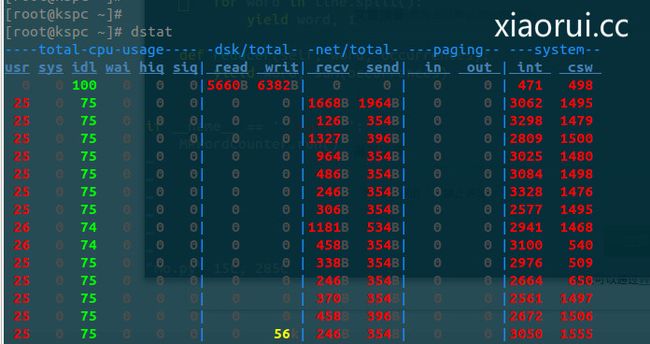咱们一般写mapreduce是通过java和streaming来写的,身为pythoner的我,
java不会,没办法就用streaming来写mapreduce日志分析。 这里要介绍一个
模块,是基于streaming搞的东西。
mrjob 可以让用 Python 来编写 MapReduce 运算,并在多个不同平台上运行,你可以:
使用纯 Python 编写多步的 MapReduce 作业
在本机上进行测试
在 Hadoop 集群上运行
pip 的安装方法:
pip install mrjob
我测试的脚本
#coding:utf-8
from mrjob.job import MRJob
import re
#xiaorui.cc
#WORD_RE = re.compile(r"[\w']+")
WORD_RE = re.compile(r"\d{1,3}\.\d{1,3}\.\d{1,3}\.\d{1,3}")
class MRWordFreqCount(MRJob):
def mapper(self, word, line):
for word in WORD_RE.findall(line):
yield word.lower(), 1
def combiner(self, word, counts):
yield word, sum(counts)
def reducer(self, word, counts):
yield word, sum(counts)
if __name__ == '__main__':
MRWordFreqCount.run()
用法算简单:
python i.py -r inline input1 input2 input3 > out 命令可以将处理多个文件的结果输出到out文件里面。
本地模拟hadoop运行:python 1.py -r local output
这个会把结果输出到output里面,这个output必须写。
hadoop集群上运行:python 1.py -r hadoop output
执行脚本 ~
[root@kspc ~]# python mo.py -r local <10.7.17.7-dnsquery.log.1> output no configs found; falling back on auto-configuration no configs found; falling back on auto-configuration creating tmp directory /tmp/mo.root.20131224.040935.241241 reading from STDIN writing to /tmp/mo.root.20131224.040935.241241/step-0-mapper_part-00000 > /usr/bin/python mo.py --step-num=0 --mapper /tmp/mo.root.20131224.040935.241241/input_part-00000 | sort | /usr/bin/python mo.py --step-num=0 --combiner > /tmp/mo.root.20131224.040935.241241/step-0-mapper_part-00000 writing to /tmp/mo.root.20131224.040935.241241/step-0-mapper_part-00001 > /usr/bin/python mo.py --step-num=0 --mapper /tmp/mo.root.20131224.040935.241241/input_part-00001 | sort | /usr/bin/python mo.py --step-num=0 --combiner > /tmp/mo.root.20131224.040935.241241/step-0-mapper_part-00001 Counters from step 1: (no counters found) writing to /tmp/mo.root.20131224.040935.241241/step-0-mapper-sorted > sort /tmp/mo.root.20131224.040935.241241/step-0-mapper_part-00000 /tmp/mo.root.20131224.040935.241241/step-0-mapper_part-00001 writing to /tmp/mo.root.20131224.040935.241241/step-0-reducer_part-00000 > /usr/bin/python mo.py --step-num=0 --reducer /tmp/mo.root.20131224.040935.241241/input_part-00000 > /tmp/mo.root.20131224.040935.241241/step-0-reducer_part-00000 writing to /tmp/mo.root.20131224.040935.241241/step-0-reducer_part-00001 > /usr/bin/python mo.py --step-num=0 --reducer /tmp/mo.root.20131224.040935.241241/input_part-00001 > /tmp/mo.root.20131224.040935.241241/step-0-reducer_part-00001 Counters from step 1: (no counters found) Moving /tmp/mo.root.20131224.040935.241241/step-0-reducer_part-00000 -> /tmp/mo.root.20131224.040935.241241/output/part-00000 Moving /tmp/mo.root.20131224.040935.241241/step-0-reducer_part-00001 -> /tmp/mo.root.20131224.040935.241241/output/part-00001 Streaming final output from /tmp/mo.root.20131224.040935.241241/output removing tmp directory /tmp/mo.root.20131224.040935.241241
执行的时候,资源的占用情况。
发现一个很奇妙的东西,mrjob居然调用shell下的sort来排序。。。。
为了更好的理解mrjob的用法,再来个例子。
from mrjob.job import MRJob #from xiaorui.cc class MRWordFrequencyCount(MRJob): #把东西拼凑起来 def mapper(self, _, line): yield "chars", len(line) yield "words", len(line.split()) yield "lines", 1 #总结kv def reducer(self, key, values): yield key, sum(values) if __name__ == '__main__': MRWordFrequencyCount.run()
看下结果:
下面是官网给的一些个用法:
我们可以看到他是支持hdfs和s3存储的 !
Running your job different ways
The most basic way to run your job is on the command line:
$ python my_job.py input.txt
By default, output will be written to stdout.
You can pass input via stdin, but be aware that mrjob will just dump it to a file first:
$ python my_job.py < input.txt
You can pass multiple input files, mixed with stdin (using the - character):
$ python my_job.py input1.txt input2.txt - < input3.txt
By default, mrjob will run your job in a single Python process. This provides the friendliest debugging experience, but it’s not exactly distributed computing!
You change the way the job is run with the -r/--runner option. You can use -rinline (the default), -rlocal, -rhadoop, or -remr.
To run your job in multiple subprocesses with a few Hadoop features simulated, use -rlocal.
To run it on your Hadoop cluster, use -rhadoop.
If you have Elastic MapReduce configured (see Elastic MapReduce Quickstart), you can run it there with -remr.
Your input files can come from HDFS if you’re using Hadoop, or S3 if you’re using EMR:
$ python my_job.py -r emr s3://my-inputs/input.txt $ python my_job.py -r hadoop hdfs://my_home/input.txt


